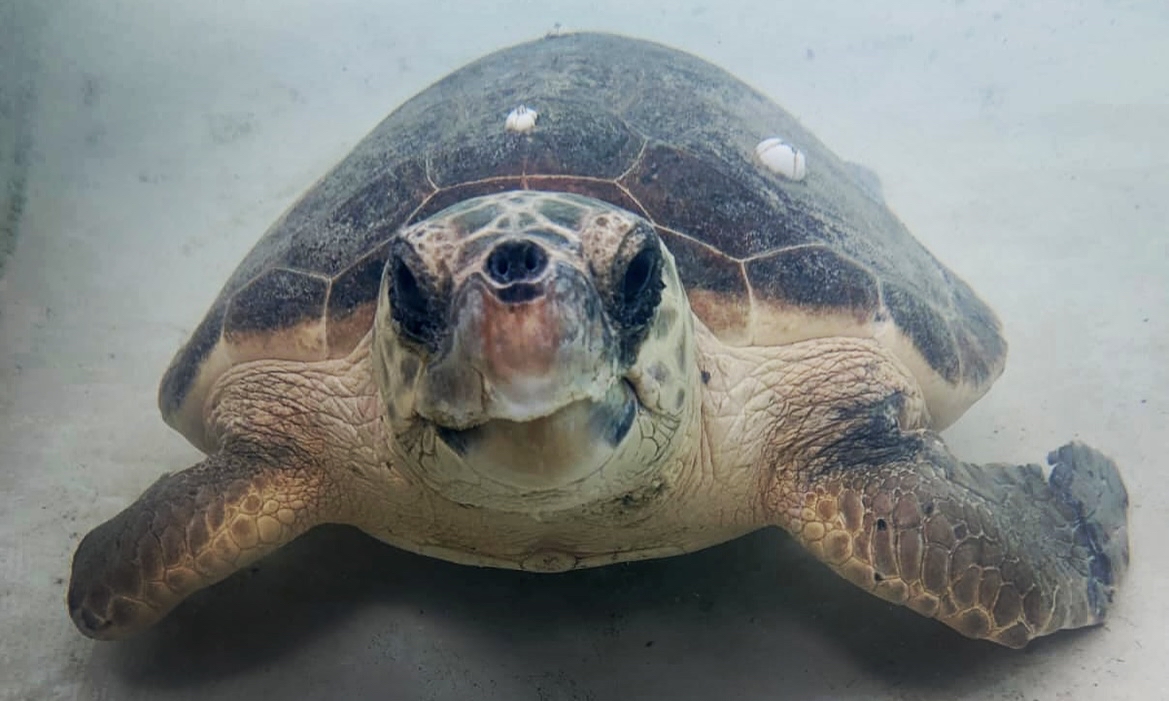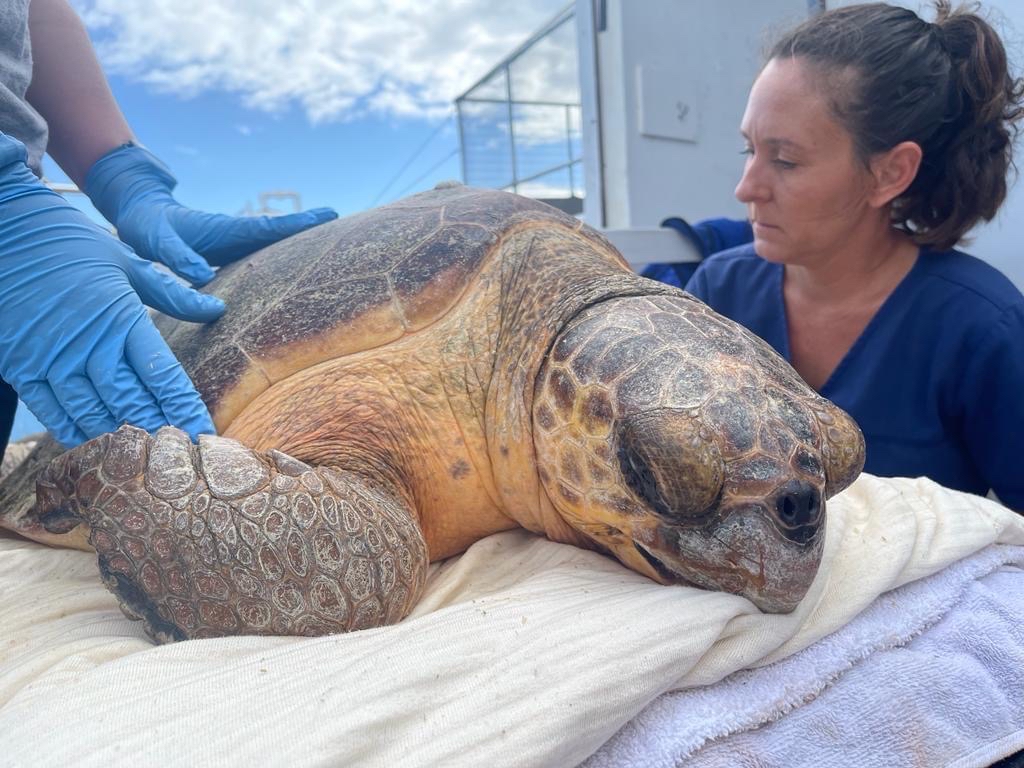
Two months ago, “Mahogany” slid into the sea and swam away from St. Croix without so much as a backward glance at the adoring fans who had saved her life and who watched her departure with a mixture of joy and tears.
There’s not much emotional feedback from a sea turtle, but that has never dampened what Erica Palmer calls her “passion” for her job as a veterinary technician.
In 15 years working on St. Thomas, Palmer said she’s treated “somewhere up around, probably 40 or 50” injured sea turtles, and while they may not be as easy to relate to as a dog or a cat, “they’re all very different.”
Mahogany is a stand-out.
That’s not just because Palmer has hung the turtle’s picture on her wall. And not just because she — along with untold numbers of other people — eagerly checks into the Sea Turtle Assistance and Rescue (STAR) Network each morning to view a satellite map that has tracked her progress for hundreds of miles.
But she’s special also because her story is one of resilience and rescue and of a community that came together for the common cause of sustaining life.

Divers first spotted what looked like an injured sea turtle at Rainbow Beach on St. Croix in February 2022. Her appearance was unusual not only because of her condition but also because she is a loggerhead sea turtle.
Marine enthusiasts are used to spotting green turtles, hawksbills and the occasional leatherback in V.I. waters. But loggerheads, named for their massive heads and strong jaws, are not known to nest on Caribbean shores. They only pass through on their way between nesting and feeding grounds — a trip that can include stops in North and South American waters. Their range in the Atlantic runs from Newfoundland to Argentina. They are also found in the Pacific.
Loggerheads are classified as “threatened” in South Atlantic waters and as even more serious “endangered” in the northeast Atlantic, according to the National Oceanic and Atmospheric Administration.
Apparently, it was the reddish-brown color of her shell that earned the St. Croix visitor the name Mahogany.

STAR kept an eye on her for a few weeks, guided by the principle that the least interference with marine life, the better. Per an account on its website, when the turtle began to show signs of major distress, remaining under a rock and surfacing only for air, STAR rescued her on March 24.
“The loggerhead had sustained injuries to her two front flippers and her shell as a result of a shark attack,” the statement reads. In fact, most of her right front flipper had been bitten off and her left was badly damaged. The shark’s teeth marks on the top of her shell were unmistakable.
She was taken to the St. Croix Animal Welfare Center where she got emergency care. The veterinarian who usually would have handled the case was off-island, so Dr. Laura Bailey said she was called in.
“We just tried to get her stabilized,” she recalled. “She was pretty badly injured. We weren’t for sure she was going to make it.”
To keep the turtle hydrated and prevent shock, “we gave it a lot of sub-q (under the skin) fluids,” Bailey said. They also gave her antibiotics and pain medication.
She credited the center’s veterinarian technician Tyler Olson with knowing how to draw blood from the turtle, which was necessary to check her condition and to see if she was able to travel for more specialized care. Had the blood sample revealed a very high rate of infection, the loggerhead would have been euthanized.
Instead, after a couple of days, she was taken to the Coral World Ocean and Reef Initiative on St. Thomas, where Palmer is the rehabilitation manager.
Coral World staff have been involved in a multitude of animal rescue efforts over the decades-long life of the marine park, but the CWORI rehab center opened in 2020.
“She was lucky” to have escaped death from the shark, Palmer said, adding that sea turtles can swim surprisingly fast and this particular one had been both young and strong.
Judging from her size and weight and the fact that her ovaries were functional, Palmer put Mahogany’s age at between 15 and 25 years, not quite fully grown but a young adult. The normal lifespan of a loggerhead is about 70 to 80 years, according to NOAA.
But the attack had done major damage, some irreversible, and her chances for continued survival on her own seemed nil.
There were internal injuries as well as infection. She was anemic. The bite on the shell had penetrated into her body. A bone died off and had to be removed. Roughly 80 percent of the right flipper was gone; they do not regenerate.
But a turtle can function with as few as two flippers, provided there is at least one front and one back, Palmer said.
So the team concentrated much of their attention on saving the remaining left front flipper, which was suffering from a bone infection.
“It took a lot of intense care,” Palmer said.
For the first two and a half months, every single day, at least four times a day, and sometimes twice that, the bandage on Mahogany’s left flipper was removed and the wound was cleaned and rebandaged. Regularly, dead tissue was also removed from around the wound.
The team also applied medical-grade honey to the wounds. “It’s anti-bacterial, anti-viral and anti-fungal,” and speeds healing by activating the process on a cellular level, Palmer said. A veterinarian supply company, Jorvet, donated it for the effort.
Meanwhile, Mahogany was getting antibiotics and pain medication and fluids.
“She had rounds and rounds of X-rays and blood work and ultrasounds,” Palmer said. Acutely aware of the danger of over-medicating a patient, the team monitored her vitals regularly.
“We try to keep them as short a time as possible,” Palmer said, but “turtles are a slow-healing animal.”
In early summer, the team was able to back off on the frequency of the wound care, but treatment continued.
By September, Mahogany seemed to be pretty healthy. Her X-rays and blood work were normal, Palmer said. She was eating well; her weight was stable and she was able to swim and to dive. Soon it was time to release her back into the ocean.
Had she been a type of turtle commonly nesting in V.I. waters, she might have been released from a St. Thomas beach to save her from the trauma associated with transport.
However, Palmer said, “We didn’t know where she was from,” and concern over disrupting her migration route outweighed concern over the effects of another transport. So she was sent back to St. Croix, where she was released from Fort Frederik Beach in mid-November.
She swam more than 500 miles to the waters off Venezuela in a few weeks, according to the tracking map. “She spent a couple weeks” there, Palmer said. As of last week, she was closer to Trinidad and Tobago.
To track her progress go to https://seaturtlecensus.com.
“The satellite tag should last about a year,” Palmer said. The battery tends to die after that and the epoxy holding the tracking device also weakens so the device falls off.

The encounter has left Palmer with fond memories.
“I think we all teared up a little bit” when Mahogany was released, she said.
But she has no illusions that the loggerhead feels the same.
“She probably thinks she was abducted by aliens,” Palmer joked.





